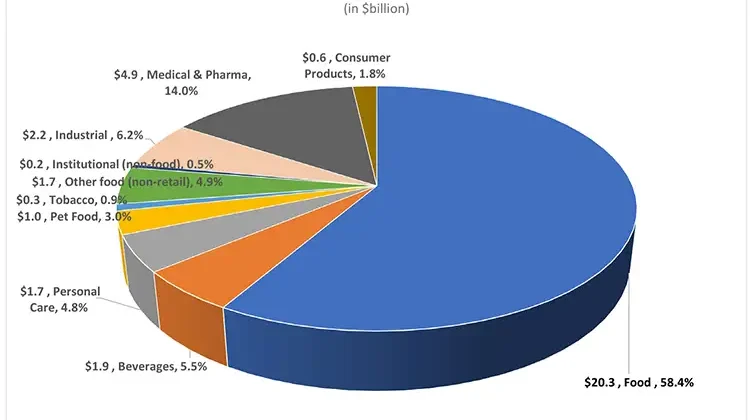
By Alison Keane, Esq., CAE, IOM, president and CEO, Flexible Packaging Assn. (FPA)
Introduction
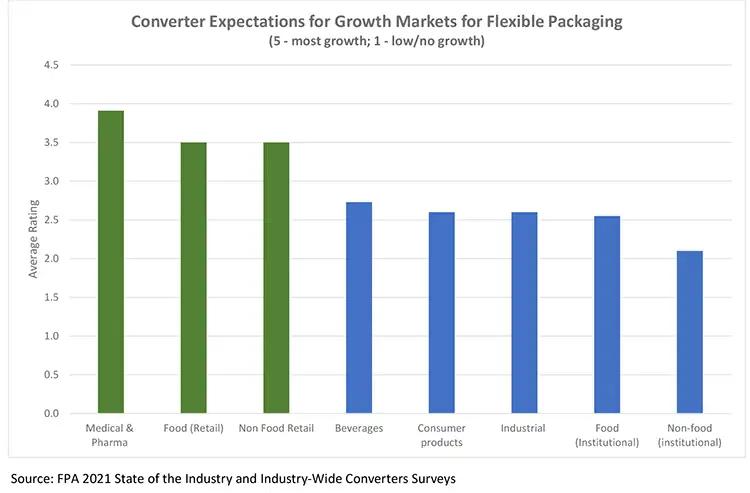
Supply-chain disruptions, workforce and raw-material availability and price were the stories of 2021 and will continue at least through Q2 2022. Much will depend on the prevalence and trajectory of the COVID-19 virus and its variants, which no one can predict; however, consumer habits certainly have changed for good and continue to rely on flexible packaging. A shift from “away-from-home” consumption to “at-home” consumption drove both the food and non-food retail sectors, including e-commerce as the delivery method. And for the first time, FPA’s annual report, The State of the US Flexible Packaging Industry, reported medical and pharmaceutical as the top growth expectation for converters, ahead of all other categories for 2022 (see Figure 1).
So, despite the lingering effects of COVID-19 almost two years since the pandemic began, the flexible packaging industry continues its strong growth with a 3.5% increase in 2021, well ahead of the -3.4% US GDP growth. The industry is estimated to be worth $35 billion, and 19% of the packaging industry in the US. Food continues to be the dominant segment, with 58.4% of the market, followed by medical and pharmaceutical at 14% and industrial, beverages, other food (non-retail) and personal-care at 6.2%, 5.5%, 4.9% and 4.8%, respectively (see Figure 2).
Packaging-policy developments to continue
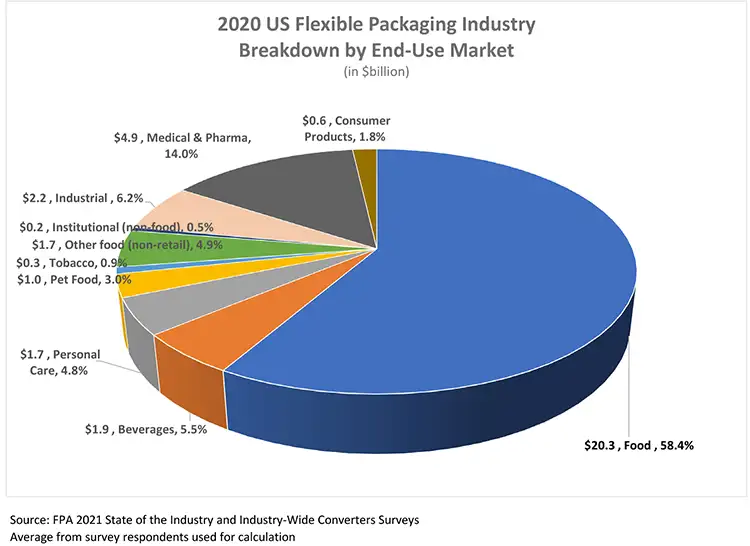
2021 did see some significant policy developments impacting the packaging industry, and plastic packaging in particular, and 2022 will see more. The most prevalent legislation we have seen, with multiple states introducing and two states passing, is extended producer responsibility (EPR), where brand owners pay into a fund for all packaging used to support current and future recycling systems. Not all EPR legislation is created equal, however, and both the Maine and Oregon bills, the first in the nation to be adopted, leave much to be desired.
In Maine, not only will the money go to a state contractor, that may or may not be a producer-run organization; the money will go to current infrastructure and not to modernizing that infrastructure, which does not now include flexible packaging. In addition, currently, there are no exceptions for any type of packaging. Determinations of recyclability and exceptions will be made through rulemakings not slated to start until mid-2022, and money from the program to municipal recycling programs isn’t slated until 2027. FPA will be vigilant in trying to except some packaging – for example, medical-device packaging – from the scheme and will continue to advocate that any additional fees paid for flexible packaging that is not recyclable today in Maine go to support future access.
In Oregon, while the legislation also gives the state far too much authority over the program, the bill at least speaks to modernizing the current recycling infrastructure and promotes all aspects of a package’s lifecycle impacts – and not just recyclability. Thus, while Oregon also will have to initiate considerable rulemaking before much about the program is clarified, FPA is more hopeful that Oregon’s program can prove to be successful long-term for film and flexibles versus Maine. Again, with rulemaking not slated till sometime this year, and implementation of the program not slated to begin until mid-2025, like Maine, things could change significantly with that much time between passage and execution.
PCR-content, PFAS and labeling
EPR wasn’t the only policy driver focusing on packaging and recycling in 2021. Several bills focused on post-consumer recycled content (PCR) in packaging; two bills focused on PFAS in paper-based packaging; and, in California, one was dedicated to labeling for recyclability, and another attempted to ban plastic e-commerce packaging. In Washington State, a packaging EPR bill was defeated and replaced by a PCR bill for plastic packaging.
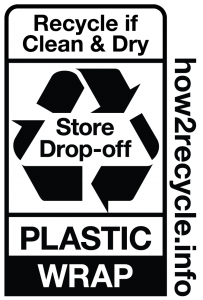
In California, a recyclable labeling bill passed, effectively outlawing the chasing arrows symbol and resin code for all but packaging that actually currently is being recycled in California. This puts in jeopardy the “How to Recycle” label in a couple of instances, including the in-store drop-off label for films (see Figure 3). The rulemaking will take place to define what now is being recycled in California, as well as a process for exemptions, new innovations and infrastructure. Nevertheless, this bill’s narrow focus on the existing recycling infrastructure leaves many recyclable flexible formats in use today stranded, and FPA believes it will create more consumer confusion and contamination – the two issues the bill’s proponents purported to address. FPA was successful in defeating an equally flawed bill that would have banned all e-commerce plastic packaging, much of it flexibles. FPA published a two-page infographic sheet (see Figure 4) on the fact and fiction surrounding e-commerce packaging, which includes bubble-wrap, dunnage and poly mailers, and pouches made of polyethylene (PE) film, which is reusable and recyclable through in-store drop-off programs [1].
The proposed ban on all plastic e-commerce packaging may be back in 2022 in California and a copycat labeling bill already popped up in New York. EPR for packaging will most certainly be back in 2022 in Washington State, Maryland, New York, Colorado, California, Connecticut, and Vermont, and there will most likely be additions to this list in the coming months. Thus, it is imperative that the supply chain continue to promote the substantial environmental and health benefits of flexible packaging and continue the innovation the industry is known for, to create greater circularity. It is also critical to promote and secure investment in modernizing recycling infrastructure for films and flexibles. We already have a two-state EPR solution with Maine and Oregon and a labeling law on the books in California that contradicts 30 other states. Labeling and PCR content rates and dates continue to pop up or be included within EPR bills as do toxicity concerns. We cannot be expected to create and label packaging differently from one state to another. Because of the need for harmonization, work at the federal level already has begun.
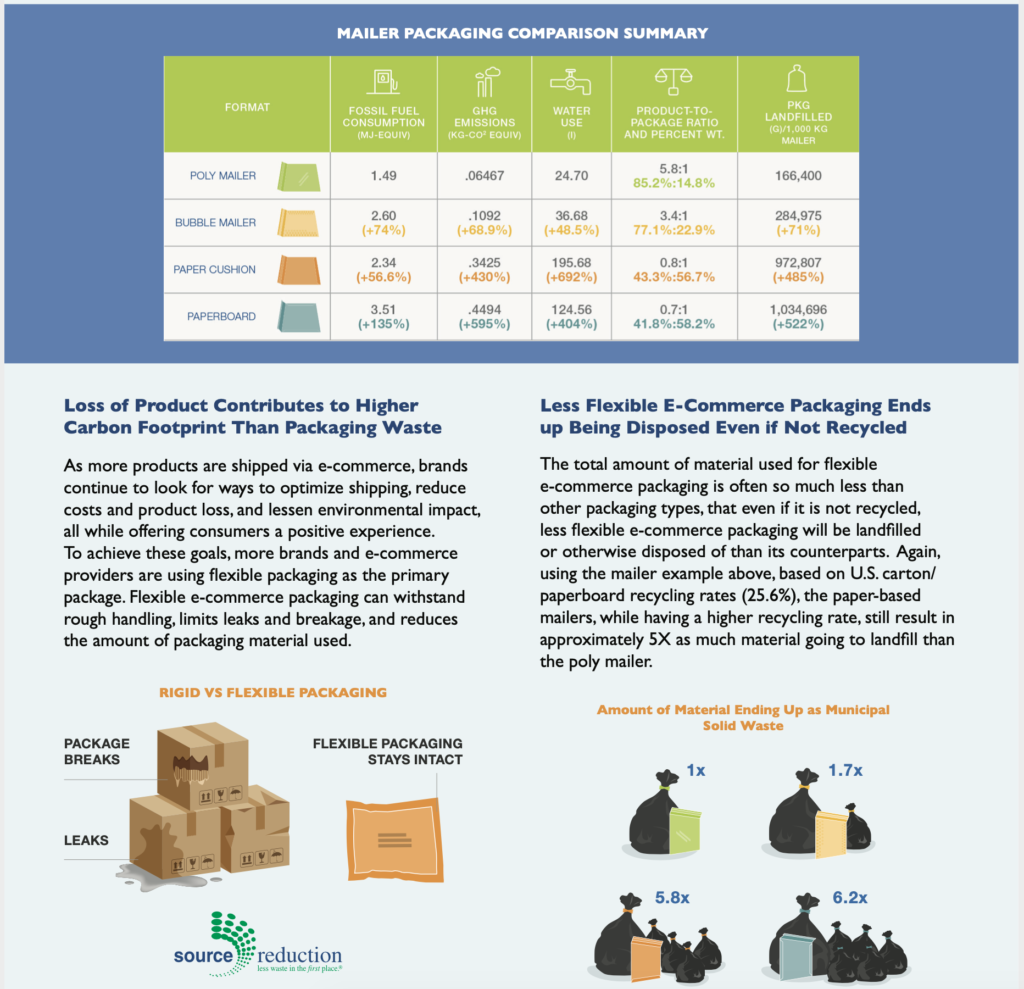
National legislation has strong investments
FPA supported and was pleased to see the bipartisan infrastructure bill signed into law in 2021. This investment includes recycling-system infrastructure as well as consumer education and outreach. Specifically, it includes a $275 million investment in a federal grant program to prevent plastic debris from polluting marine environments and having adverse effects on human health and wildlife, and $75 million to help educate households and consumers about residential and community recycling. This is good news for working toward the ultimate goal of modernizing our recycling system to include flexibles.
In addition, late in 2021, the US Environmental Protection Agency (EPA) published its National Recycling Strategy: Part One of a Series on Building a Circular Economy, (Strategy), which is focused on modernizing the national recycling system [2]. The report identifies strategic objectives and stakeholder-led actions to create a stronger, more resilient and cost-effective recycling system. It is the first in a series dedicated to building a circular economy, where material use is reduced, materials are redesigned to be less resource-intensive and waste is recaptured as a resource for new products. Sound familiar? It should – as FPA has been advocating for the same approach to modernizing the domestic recycling system and providing an “on-ramp” for flexible packaging, which does not have a clear pathway to circularity under the existing system.
The Strategy highlights several key issues with the current recycling system. These include consumer confusion and subsequent contamination, recycling infrastructure not keeping pace with today’s waste stream and limited markets for recycled materials. EPA also highlights the issue of food waste and its environmental harm. To address these challenges, EPA recognizes five objectives to ultimately increase the national recycling rate to 50% by 2030. These plans align closely with FPA’s stated position on circularity, our work with the Recycling Leadership Council and our 2021 report, A Flexible Packaging Path to a Circular Economy: Flexible Packaging Sustainability Roadmap [3], which provides information, knowledge and insights related to flexible packaging and sustainability, circular economy, legislative trends, impacts to the industry along with key outcomes and actions to enable the industry to align with circular-economy principles where materials are collected, sorted, processed and turned back into new products or packaging.
Finally, the Federal Trade Commission is updating its “Green Guides,” which dictate claims that can be made on packages concerning a host of attributes, such as recyclability, thus protecting consumers from false, deceptive or misleading claims made on product labeling. FPA strongly supports a federal approach to labeling and looks forward to being part of the stakeholder process for the update.
Conclusion
With two EPR laws on the books in 2021 and more to come this year, as well as myriad labeling, post-consumer recycled content and toxins in packaging legislation pending or being implemented, this is the time to “UNITE FOR FLEXIBLES” – become part of these efforts with FPA.
References
- https://www.flexpack.org/publication/RG93bmxvYWQ6NjUy/download
- https://www.epa.gov/recyclingstrategy
- https://www.flexpack.org/resources/sustainability-resources#flexible-packaging-path-to-a-circular-economy:-flexible-packaging-sustainability-roadmap
More info: 410-694-0800, email: fpa@flexpack.org, www.flexpack.org

